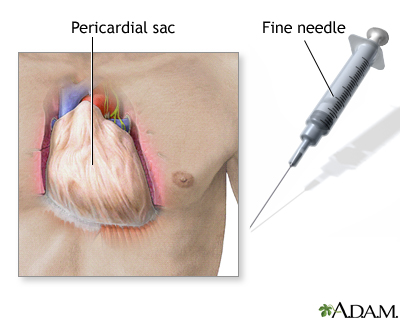Pericardiocentesis
Pericardial tap; Percutaneous pericardiocentesis; Pericarditis - pericardiocentesis; Pericardial effusion - pericardiocentesis
Pericardiocentesis is a procedure that uses a needle to remove fluid from the pericardial sac. This is the tissue that surrounds the heart.
How the Test is Performed
The procedure is most often done in a special procedure room, such as a cardiac catheterization laboratory. It may also be done at a patient's hospital bedside. A health care provider will put an IV into your arm in case fluids or medicines need to be given through a vein. For example, you may be given medicines if your heartbeat slows or your blood pressure drops during the procedure.
IV
Intravenous means "within a vein. " Most often it refers to giving medicines or fluids through a needle or tube inserted into a vein. This allows th...
The provider will clean an area just below or next to the breastbone or below the left nipple. Numbing medicine (anesthetic) will be applied to the area.
The doctor will then insert a needle and guide it into tissue that surrounds the heart. Often, echocardiography (ultrasound) is used to help the doctor see the needle and any fluid drainage. An electrocardiogram ( ECG ) and x-rays (fluoroscopy) may also be used to help with positioning.
Echocardiography
An echocardiogram is a test that uses sound waves to create pictures of the heart. The picture and information it produces is more detailed than a s...

ECG
An electrocardiogram (ECG) is a test that records the electrical activity of the heart.

Once the needle has reached the correct area, it is removed and replaced with a tube called a catheter. Fluid drains through this tube into containers. Most of the time, the pericardial catheter is left in place so draining may continue for several hours.
Surgical drainage may be needed if the problem is hard to correct or comes back. This is a more invasive procedure in which the pericardium is drained into the peritoneal (abdominal) or chest (pleural) cavity. This may need to be done when you are under general anesthesia.
How to Prepare for the Test
You may not be able to eat or drink for 6 hours before the test. You must sign a consent form.
How the Test will Feel
You may feel pressure as the needle enters. Some people have chest pain , which may require pain medicine.
Chest pain
Chest pain is discomfort or pain that you feel anywhere along the front of your body between your neck and upper abdomen.

Why the Test is Performed
This test may be done to remove and examine fluid that is pressing on the heart. It is most often done to find the cause of a chronic or recurrent pericardial effusion .
Pericardial effusion
Pericarditis is a condition in which the sac-like covering around the heart (pericardium) becomes inflamed.

It may also be done to treat cardiac tamponade , which is a life-threatening condition.
Cardiac tamponade
Cardiac tamponade is pressure on the heart that occurs when blood or fluid builds up in the space between the heart muscle and the outer covering sac...

Normal Results
There is normally a small amount of clear, straw-colored fluid in the pericardial space.
What Abnormal Results Mean
Abnormal findings may indicate the cause of pericardial fluid accumulation, such as:
-
Cancer
Cancer
Cancer is the uncontrolled growth of abnormal cells in the body. Cancerous cells are also called malignant cells.
Read Article Now Book Mark Article - Cardiac perforation
- Cardiac trauma
-
Congestive heart failure
Congestive heart failure
Heart failure is a condition in which the heart is no longer able to pump oxygen-rich blood to the rest of the body efficiently. This causes symptom...
 ImageRead Article Now Book Mark Article
ImageRead Article Now Book Mark Article -
Pericarditis
Pericarditis
Pericarditis is a condition in which the sac-like covering around the heart (pericardium) becomes inflamed.
 ImageRead Article Now Book Mark Article
ImageRead Article Now Book Mark Article - Renal failure
- Infection
-
Rupture of a ventricular
aneurysm
Aneurysm
An aneurysm is an abnormal widening or ballooning of a part of an artery due to weakness in the wall of the blood vessel.
 ImageRead Article Now Book Mark Article
ImageRead Article Now Book Mark Article
Risks
Risks may include:
- Bleeding
- Collapsed lung
- Heart attack
- Infection (pericarditis)
-
Irregular heartbeats (
arrhythmias
)
Arrhythmias
An arrhythmia is a disorder of the heart rate (pulse) or heart rhythm. The heart can beat too fast (tachycardia), too slow (bradycardia), or irregul...
 ImageRead Article Now Book Mark Article
ImageRead Article Now Book Mark Article - Puncture of the heart muscle, coronary artery, lung, liver, or stomach
- Pneumopericardium (air in the pericardial sac)
References
LeWinter MM, Hopkins WE. Pericardial diseases. In: Bonow RO, Mann DL, Zipes DP, Libby P, Braunwald E, eds. Braunwald's Heart Disease: A Textbook of Cardiovascular Medicine . 10th ed. Philadelphia, PA: Elsevier Saunders; 2015:chap 71.
Little WC, Oh JK. Pericardial diseases. In: Goldman L, Schafer AI, eds. Goldman's Cecil Medicine . 25th ed. Philadelphia, PA: Elsevier Saunders; 2016:chap 77.
-
Aneurysm description
Animation
-
Heart, front view - illustration
The external structures of the heart include the ventricles, atria, arteries and veins. Arteries carry blood away from the heart while veins carry blood into the heart. The vessels colored blue indicate the transport of blood with relatively low content of oxygen and high content of carbon dioxide. The vessels colored red indicate the transport of blood with relatively high content of oxygen and low content of carbon dioxide.
Heart, front view
illustration
-
Pericardium - illustration
The pericardial sac surrounds and protects the heart within the chest cavity.
Pericardium
illustration
-
Heart, front view - illustration
The external structures of the heart include the ventricles, atria, arteries and veins. Arteries carry blood away from the heart while veins carry blood into the heart. The vessels colored blue indicate the transport of blood with relatively low content of oxygen and high content of carbon dioxide. The vessels colored red indicate the transport of blood with relatively high content of oxygen and low content of carbon dioxide.
Heart, front view
illustration
-
Pericardium - illustration
The pericardial sac surrounds and protects the heart within the chest cavity.
Pericardium
illustration
Review Date: 5/5/2016
Reviewed By: Michael A. Chen, MD, PhD, Associate Professor of Medicine, Division of Cardiology, Harborview Medical Center, University of Washington Medical School, Seattle, WA. Also reviewed by David Zieve, MD, MHA, Isla Ogilvie, PhD, and the A.D.A.M. Editorial team.




